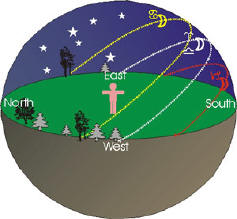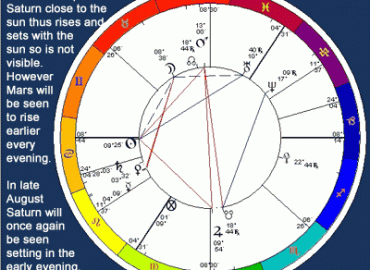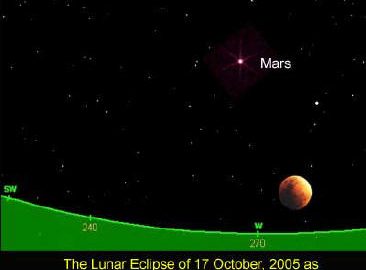Bernadette Brady
January 2006
About every 800-to-1000 years a particular sky narrative is repeated. It is not necessarily one of the great sky narratives. It is a simple story of power shifting from kings to their heirs, from Prime Ministers to Chancellors, from Presidents to Vice Presidents; the end of one era and the beginning of another. Sometimes it occurs in small clusters over a fifty year period. Sometimes it occurs just once, then repeats itself after 800-to-1000 years.
It is a pattern involving Saturn in the stars of Cancer being over-ridden by the full moon at the time when Jupiter sits comfortably in the place of the king – the stars of the Scales.
In Assyrian astrological thinking, Saturn represented the king and for those of you who are regular readers of this newsletter, you would be aware that this idea still appears to hold potency. Also, we have noted that in Babylonian/Assyrian omen-astrology, Jupiter represents the Crown Prince or the one who is full of potential, the person who is the “heir” but still subservient to the king. Added to this we have also observed the influence of the moon. Cast in the role of the moon god, Sin, this all-important character appears to empower or dis-empower other planets or stars, either by travelling above or below them or by embracing them in a halo. This latter is an expression of visual astrology which we are not able to fully explore as it is a weather feature but which could indeed be useful as a way of localising predictions.
Now we have already observed the retrograding of Saturn amongst the stars of Gemini. Last February 2005 [1] the moon rode over the top of Saturn (northern hemisphere view) while it, Saturn, was retrograding. This foretold of a gathering of kings and indeed there came to pass just such gatherings with the cardinals in Rome to elect a new pope, as well as the gathering of dignitaries in London for the marriage of the crown prince, Charles. Now, in 2006, Saturn has moved and is retrograding amongst the stars of Cancer. It has been retrograde since December, 2005, and will not go direct until April, 2006.
Saturn retrograde in Cancer was of particular note to the Assyrians. In the seventh century B.C.E. the priest Nabu-ahhe-eriba noted a stationary Saturn amongst the stars of Cancer and wrote the following to his king:
If the Scales stand in a stable position:
there will be reconciliation and peace in the land.
The Scales are (equivalent) to Saturn.
Their position is stable means that Sat-
urn stands in Cancer [2].
Thus if Saturn (also called the Scales and linked to those stars) stands in a stable position in the stars of Cancer, then such stillness or stability is reflected as peace in the land, the law is upheld, justice is done. Therefore we would expect that as Saturn moves through its retrograde cycle in the stars of Cancer, that the turbulence of the last year will begin to calm, that a measure of stability will return to the earth. However, as Saturn stands still amongst the stars of Cancer, the moon god, Sin, heralds a problem. The moon, which is now approaching its greatest northern declination, will, as it becomes full in January, actually pass over the top of Saturn (northern hemisphere view ) on the night of 15th January, 2006, above his “normal” path.
Unpacking the Sky Story
Below is the view of this sky narrative over three consecutive evenings. Each night as Jupiter rises, the full moon will be seen with Saturn, the king. To the Assyrians the moon god, Sin, was deemed to be a carrier of power and indeed he needs to “see” the sun every month (a full moon) for the kingdom to continue in its prosperity. So for Sin to be seen to leave his “normal” path at the time of his greatest power, the full moon, is a potent symbol. Additionally for Sin to also climb over the top of the king (Saturn) at this potent time is an indication that Sin is challenging or altering the power of the king. This power-yielding happens quickly, with little disruption, for Saturn is amongst the stars of Cancer, an indication of the stability of the kingdom. So possibly we are not looking at revolutions but rather corrections and/or the legal shifting of power.
Adding to this story of the yielding of power is the fact that Jupiter, the crown prince, is at this time travelling through the constellation Libra. Libra was also known to the Assyrians as the Scales. As already discussed, the Scales were considered to be a group of stars closely linked to the King (Saturn) and indeed the stars of Libra (Scales) and the planet Saturn could be interchanged with each other at any time. Indeed this may well be one of the seeds for Saturn’s exaltation in the sign of Libra.
So the crown prince sits in the place of the king just as the moon god, Sin, indicates that the king loses or yields power. Does the crown prince therefore gain kingly power?
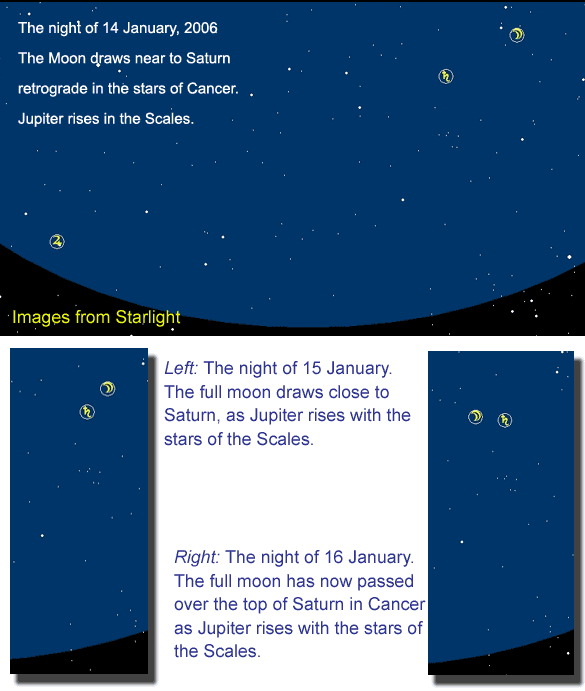
The patterns of past history
This pattern is infrequent. It occurred in the years 1589 B.C.E. and 1530 B.C.E which coincides with the period of the beginning of the New Kingdom in Egypt. It occurred again in the year 676 B.C.E., the year of the death of the Assyrian king Khumma-Khaldash II and the beginning of the decline of the Assyrian empire. It also occurred in the year 239 C.E., the year of the death of the Chinese emperor Wei Qi Wang which eventually lead to revolution. Also in that year the Roman Emperor Maximinus was assassinated. (The Jupiter/Saturn/Full Moon pattern of 239 C.E. had Mars – Nergal – in the bow of the archer, suggestive of battles or blood shed. For those of you who own Starlight, you will find it interesting to look at a sky map for the full moon in Cancer in 239 C.E. and observe the position of Mars located in the arrow of Sagittarius).
From the blood-stained hands that assassinated Roman emperors to Chinese mutiny and rebellion, the pattern reappeared again the year 1093 and saw three princes gain crowns in Scotland, Portugal and Russia (Kievan Rus). However, with Mars once again returning to the stars of Sagittarius, this transition of power from king to prince also involved war.
The pattern in 2006
In 2006, after 913 years, the pattern returns to the sky. In the early evening of 15th January, 2006, Saturn and the full moon will rise together just after sunset. As Saturn climbs higher in the sky, so will the moon until, by the time they are setting, the full moon will be seen to be sitting above Saturn which is retrograding amongst the stars of Cancer. At the same time Jupiter will rise amongst the stars of the Scales.
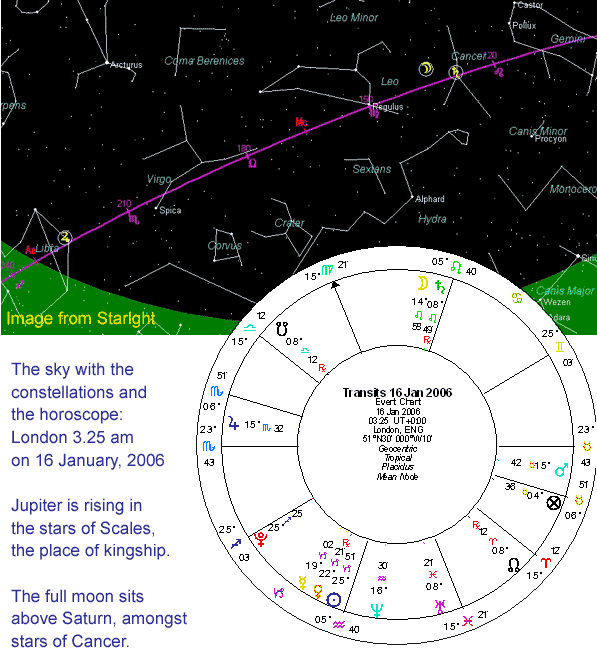
An astrologer’s eye looking at this horoscope will simply see a Saturn-Moon conjunction in Leo (tropical zodiac sign) with Jupiter in Scorpio (tropical zodiac sign) – see image above. In our horoscopes we have seen this square active for some months and the moon, in its monthly orbit, once again forming a conjunction to Saturn, would probably not be cause for intense study. Yet in visual astrology this is quite a different picture.
According to the Assyrians, the king stands tall and stable in the stars of Cancer, his strongest position, his most loved or most powerful position. Whilst enjoying this strong position, an event unfolds. This is not necessarily a violent episode, as Nergal (Mars ) is not in Sagittarius but rather is with the stars of the Hired Man (stars of Aries). This event results in the person with power dying or stepping back from the position of power. The power is naturally handed over to the crown prince, as Jupiter is with the stars of the Scales, the place of the king. Furthermore, the event may well be precipitated by a third person, as Mars is amongst the stars of the Hired Man.
There is, however, nothing to help us with timing in this sky narrative except to say that we are looking at events for the year 2006. I personally think there is a greater potential for this to come to pass before Saturn goes direct in April but this is simply an educated guess. Nor is there anything to help us understand where this power shift will take place. We naturally think this will occur in our own western culture but this is our bias and the sky may be talking of other “kingdoms” or kingdoms of money and wealth, rather than kingdoms of military might or political power.
On a Personal Level
Moreover what is important to understand is that, just as this sky narrative can talk of the lives of kings and queens, presidents or prime ministers, it can also talk about ordinary people with ordinary lives. The sky pattern is suggesting that 2006 is a year of potential power shifts on all levels of society. So if you are a “crown prince” in your work or in your life, then this is the year where the sky patterns are conducive for you to gain a crown. Sit down and think about what you can logically expect to gain in this year, what is within your “right” to reach out and claim – success, promotion, new life style, and so forth. This sky pattern is not promising this to you but it does suggest a supportive environment for your endeavours. If, however, you wear a “crown”, then look around for ways of constructive power-sharing, for remember what Shakespeare said: “Uneasy lies the head that wears a crown.”[3]
One final point to remember is that an infrequency of a sky pattern does not mean that it is a powerful symbol. Thus just because this pattern only occurs roughly every thousand years does not, by default, mean that it is potent. However, it would seem that history does support the strong focus that the Assyrians placed on Saturn retrograde in Cancer and the Moon’s path. Once again, as is the case with this newsletter, it is a game of “wait and see”.
Sources
[1] See February V.A.N. article, The Gathering of Kings.
[2] Hunger, Herman. (1992). Astrological Reports to Assyrian Kings. Helsinki, Finland: Helsinki University Press. pg. 24
[3] Shakespeare, William. King Henry the Fourth, Part Two.


